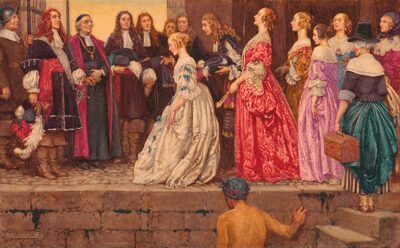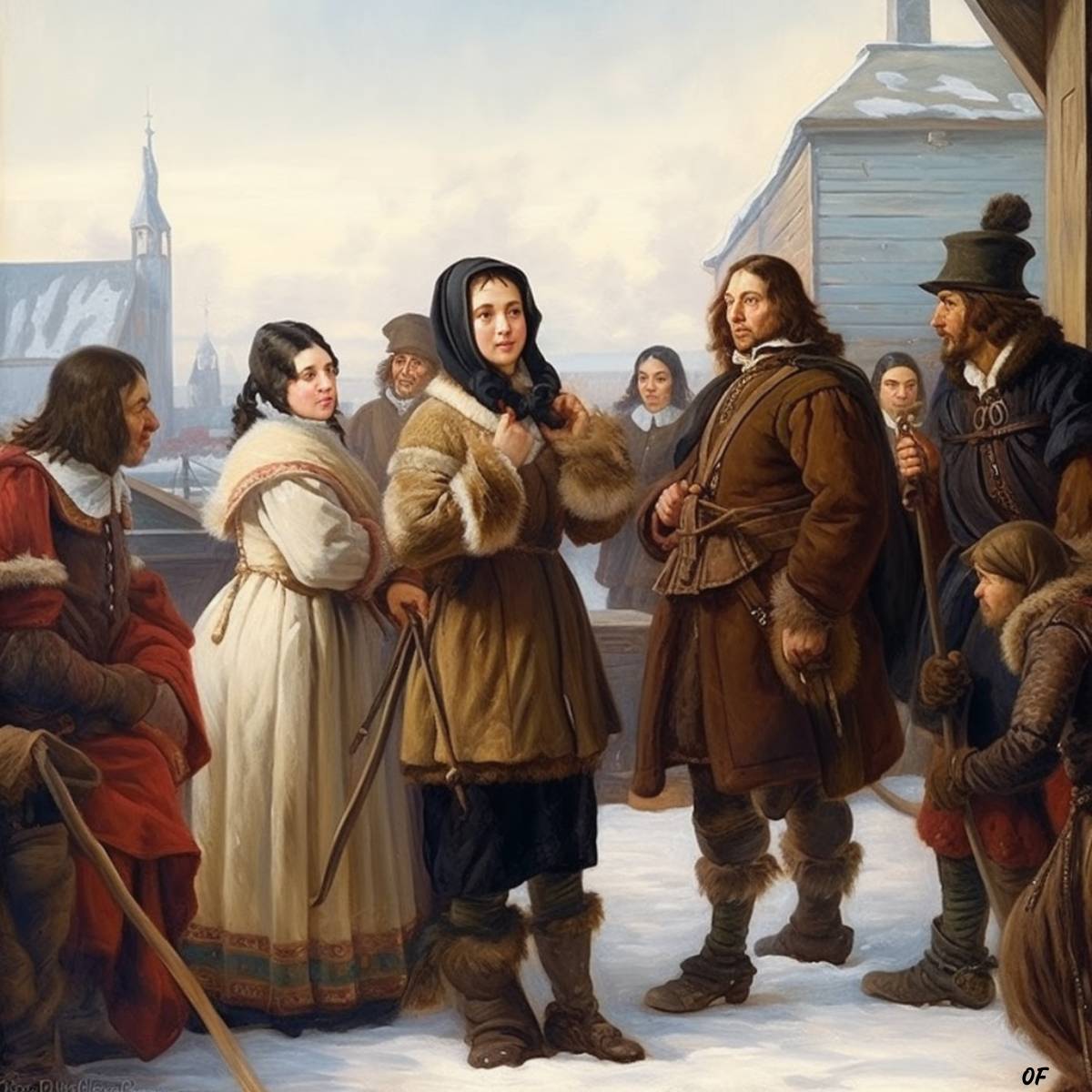In the 17th century, New France—the modern state of Quebéc in Canada—was being settled by working men and soldiers. But they had one big problem: not enough women!
This was of great concern to the leaders of New France. They worried that men would go home when they finished their service rather than settle there, which they needed to compete with the booming populations of the growing English colonies. The French authorities also worried about the morals of the men who stayed. In French Catholic culture, at that time, a man needed a wife!
To deal with this problem, Jean Talon, the Intendant of New France, wrote to King Louis XIV and suggested that the king of France sponsor at least 500 suitable young women to come to New France as young brides.
Happy to oblige, King Louis XIV sent around 800 women to the colony between 1663 and 1673. These women were the Filles du Roi—the King’s Daughters—and they were the ancestors of many Canadians today.
Who were les Filles du Roi

It was not enough to just send any women to New France. The young women needed to be desirable brides to support the colony and encourage men to put down roots and start families.
There was a severe shortage of marriageable women arriving from France. Few wanted to abandon their lives to travel to an unknown land that promised a difficult life. Consequently, the French crown had to actively recruit young women and make the prospect attractive. The king offered not only passage to New France but also a dowry and support in starting a new life, with their new husbands, in the new world.
Most of the young women who were recruited were between the ages of 12 and 25 and were from the convents and orphanages of the Paris area, Normandy, and the western region. However, some were also from Germany, Portugal, and England.
While the young women did not have much in terms of money and possessions, they each were required to have a recommendation from their local Parish priests promising they were a virgin and of good moral character.
Some daughters with a more aristocratic background were also recruited, either because their families had fallen on hard times or had many girls to “spare.” These young women were earmarked for officers and gentlemen in Canada.
Potential Filles du Roi also had to have good health and a certain “toughness” about them since the French government knew that life in New France would be hard. The six-month sea journey alone represented a genuine danger.
Around 800 Filles du Roi arrived in Canada between 1663 and 1673. In the first year, there were just 36, then around 100 were sent in 1665, and a similar number was sent repeatedly in the following years. Most found husbands not long after arriving, but Jean Talon also sent some back to Europe, claiming that they did not meet the rigorous standards that had been agreed upon between himself and King Louis XIV.
The Filles du Roi were not the first women recruited to come to Canada. Before this, private groups recruited filles à marier, marriageable girls, to come to the colony. But these organizations did not have the financial backing to make the trip attractive to the young women or the wives attractive to the colonists.

Filles du Roi arrived with a dowry
The shortage of women in New France meant that it was not difficult for a Fille du Roi to find a husband. This was especially true for the prettiest of the girls. The ships carrying them arrived in Québec city and then sailed up the Saint Lawrence River to Trois-Rivieres and Montréal. The prettiest girls tended to disembark and get married in Québec.
But the Filles du Roi also had the advantage of arriving with a dowry. Each young woman was sponsored by the king. This is why they were called the King’s Daughters. This implied that they were wards of the king rather than of royal descent.
The crown paid the French East India Company to transport the young women to New France and also gave them a modest allowance to put together a trousseau, which is a hope chest. When Filles du Roi were sent to the French colony in Louisiana in the 18th century, they also carried these chests and were called “Casket Girls” for the distinctive shape of the travel chests.
Each woman also received a king’s gift for their marriage, which was valued at 400 livres. The French government usually did not have the physical coin to distribute this amount, so it would instead gift things such as livestock.
The value of the French livre was set at one pound of silver. But in the colonies, the livre was worth less than half of its value in France. This livre dowry was more or less the equivalent of what a laborer would earn in a year at that time. In terms of buying power, a cow cost around 50 livres, while 20 acres of cleared farmland cost around 500 livres.
Since the purpose of the Filles du Roi was to help increase the population of the colony, King’s Daughters who birthed ten children or more also received an annual pension from the crown. This was no easy feat, considering the chainsaw was invented as a birthing tool!

Each Fille du Roi had a marriage contract
The time it took for a newly arrived Fille du Roi to find a suitable husband varied. Some were married within months of arriving: others needed a few years.
The Filles du Roi that arrived in Montreal were taken in by the Société Notre Dame de Montréal, which housed the girls in their convent, and later in a farmhouse. Marguerite Bourgeoys, one of the nuns there, was the first to use the term les Filles du Roi (or Filles du Roy using the spelling of the day) in her writings to distinguish the King’s Daughters from the female immigrants who arrived in New France independently.
Matches were negotiated, and the girls would ask about potential husbands’ homes, land, profession, and finances. Men who were keen to marry one of the Filles du Roi often invested heavily in their habitation for a year before courting. A decent place to live was one of the top priorities for the King’s Daughters.
When a match was made, the Filles du Roi were engaged in the church, though the normal banns were often overlooked to expedite matches. The pair would then sign a marriage contract before officializing their marriage after a proper period of time. It is unclear whether courting practices like bundling took place before the marriage.
These marriage contracts protected the girls if something happened to their future husbands before their wedding. Life was harsh in the new colony, and sudden deaths were to be expected. It also allowed the girls to pull out of the marriage if they decided that the man was unsuitable once they got to know him better.
Many of the Filles du Roi used this clause to pull out of a marriage and seek a new contract with a different man. Their dowry made them very attractive wives, so they had significant power to choose the men they wanted.
The King’s Daughters colonize Canada
The Filles du Roi were a rousing success. Records suggest that there were 835 marriages of immigrants in the colony between 1663 and 1671, and of those, 774 were of the Filles du Roi. In 1671, more than 700 children were born to the Filles du Roi. While the King’s Daughters represent only 8% of all immigrants to Canada during the colony’s history, they account for almost half of the women who immigrated to Canada.
In 1663, the population of New France was around 3,200. By 1672, it had more than doubled to 6,700. The French government stopped sending Filles du Roi to Canada in 1673 and called the project a success.
The project was so successful that it was emulated half a century later. In the first three decades of the 18th century, the French colonies in Louisiana and the West Indies requested their own Filles du Roi.
The legacy of the Filles du Roi

The projects after Canada’s were of mixed success since significantly less care was taken in choosing appropriate marriageable women to send. On one occasion, the French government sent women from their houses of correction, and the Louisiana colonists refused to marry them. The Casket Girls who arrived in New Orleans in 1728 were suspected of being vampires!
But the Canadian Filles du Roi were a resounding success and became the founding mothers of modern Canada. Many North Americans can trace their ancestry to these brave women. Hilary Clinton, Angeline Jolie, and Madonna all claim descent from these female immigrants.
The Filles du Roi also brought with them French culture and the French language of Paris, helping embed the king’s French in the streets of modern Quebec.


